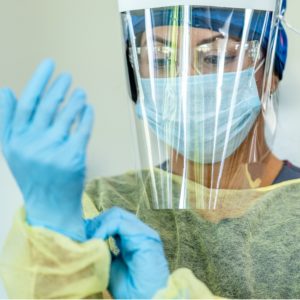Interventional Care


We notice that you are visiting us from . This site only services US-based visitors. Would you like to visit the site that is appropriate for your location?

One may think that this blog is about the emotional or social impact of the human touch. But let’s face it, in 2022, it’s all about the virus – Coronavirus, that is (the COVID-19 pandemic). In this blog, I will be reviewing the impact of human touch (via finger pad) regarding transmissibility of the human coronavirus 229E (HCoV 229E), as the surrogate for SARS-CoV-2, from fomites (i.e., environmental surfaces).
Non-enveloped viruses have been well studied from previous research showing the transfer efficiency from fomite to fingerpad.1.2 Recently, Drs. Gerba and Rutala and colleagues studied the transfer efficiency of enveloped viruses to human fingers publishing their findings in a concise communication to the infection prevention community.3 As we know, enveloped viruses such as influenza, rhinovirus, and respiratory syncytial virus can be transmitted by contaminated hands touching human portals of entry such as the eyes, the mouth, or the nose. Contamination of the hands generally occurs from touching fomites that serve as a reservoir for the virus. Due to the lack of hand hygiene to eliminate the virus prior to touching the face, the infection transmission is completed. The role of fomites in the transmission of coronavirus SARS-CoV-2 is not well understood. The aim of the study, to evaluate the transfer efficiency of human coronavirus 229E from various materials/fomites to human fingers, is one step towards understanding this link in SARS-CoV-2 chain of transmission.
The experiment utilized types of materials commonly found in healthcare environmental surfaces as the test carriers, including stainless steel, glazed porcelain, glass, laminate, and Formica, and the carriers were inoculated with the test organism human coronavirus 229E (HCoV 229E). The study was performed under controlled conditions utilizing a transfer protocol from carrier to finger as described by Lopez et al2 by placing the finger pad directly onto the contaminated carrier, achieving full contact for 10 seconds. An initial method for retrieving virus from contaminated fingers using the nylon swab method described by Rusin et al4 yielded low numbers. An alternate method was then used where the contaminated fingers were washed in a retrieval solution containing antibiotics within a sterile petri dish, using rotational and physical friction to facilitate viral removal for 10 seconds. Dilutions and plating onto host cell monolayers completed the process (refer to original article for complete details3).
The highest numbers of HCoV 229E were transferred from glazed porcelain to the fingers compared to stainless steel, which demonstrated the lowest mean transfer efficiency of the virus. Glass and Formica exhibited high numbers as well, leaving laminate just above stainless steel in transfer efficiency.
So, what is the impact of the human touch during the COVID-19 pandemic? This study shows the potential for coronaviruses (e.g., SARS-CoV-2) to be transferred from various fomites/surfaces to human fingers. Efficiency of the transfer may vary due to multiple factors not completely understood (perhaps fomite to virus hydrophobicity or electrostatic interactions), however, the chain of transmission could be complete. For this reason, standard infection prevention measures, such as environmental disinfection and hand hygiene would be recommended to decrease the transfer from fomites to fingers from occurring.
Science only tells one story about the impact of human touch during the pandemic. The pandemic has highlighted the emotional and social impact of the human touch. The touch of the healthcare worker on a patient sick with the disease, the touch of a loved one post quarantine, or the touch of a stranger providing help for those in need. In my eyes, the impact of the human touch can be measured in many ways. Don’t you agree?
1Ansari SA, Sattar SA, Springthorpe VS, Wells GA, Tostowaryk W. Rotavirus survival on human hands and transfer of infectious virus to animate and nonporous inanimate surfaces. J Clin Microbiol 1988;26:1513–1518.
2Lopez GU, Gerba CP, Tamimi AH, Kitajima M, Maxwell SK, Rose JB. Transfer efficiency of bacteria and viruses from porous and nonporous fomites to fingers under different relative humidity. Appl Environ Microbiol 2013;79:5728–5734.
3Gerba CP, et al. (2021). Transfer efficiency of an enveloped virus, human coronavirus 229E, from various hard surface fomites to finger pads of the hands. Infection Control & Hospital Epidemiology, https://doi.org/10.1017/ice.2021.428
4Rusin P, Maxwell S, Gerba, CP. Comparative surface-to-hand and finger-to-mouth transfer efficiency of gram-positive bacteria, gram-negative bacteria, and phage. J Appl Microbiol 2002;93:585–592.